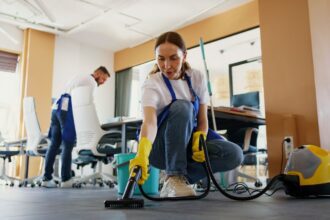High-traffic commercial areas, such as shopping malls, airports, and office buildings, pose unique cleaning challenges. With thousands of people passing through daily, maintaining cleanliness becomes a daunting task. In this article, we’ll explore effective strategies for keeping high-traffic commercial areas clean and hygienic.
Develop a Cleaning Schedule
To maintain cleanliness in high-traffic commercial areas, it’s essential to develop a cleaning schedule that ensures regular cleaning and maintenance. Allocate specific times of the day or week for different tasks, such as:
- Daily: Sweep and mop floors, empty trash cans, and restock supplies.
- Weekly: Deep clean high-touch areas, like bathrooms and break rooms.
- Bi-Weekly: Clean windows and mirrors.
Designate Cleaning Zones
Divide the commercial area into cleaning zones to ensure that every section receives adequate attention. Assign specific zones to cleaning staff or contractors to maintain accountability. For example:
- Zone 1: Entranceways and corridors
- Zone 2: Retail spaces and food courts
- Zone 3: Bathrooms and break rooms
Use Effective Cleaning Tools
Invest in high-quality, durable cleaning tools that can withstand heavy use. Consider using:
- Industrial-grade vacuum cleaners with HEPA filters to capture dust and allergens.
- Microfiber cloths that pick up dirt and grime easily.
- Disinfectant sprays or wipes to sanitize high-touch areas.
Implement a Waste Management System
A well-organized waste management system helps maintain cleanliness in high-traffic commercial areas. Ensure:
- Adequate trash cans are placed strategically throughout the area.
- Recycling bins are available for paper, plastic, and glass waste.
- Regular waste collection schedules are maintained.
Promote Hand Hygiene
Encourage hand hygiene among visitors, employees, and cleaning staff to prevent the spread of illnesses. Install:
- Hand sanitizer dispensers at entrances and high-touch areas.
- Soap dispensers in bathrooms with warm water and paper towels.
Train Cleaning Staff
Provide comprehensive training to cleaning staff on effective cleaning techniques, safety protocols, and equipment operation. Ensure they understand:
- The importance of wearing personal protective equipment (PPE) like gloves and masks.
- How to handle hazardous materials and chemicals safely.
- Procedures for reporting spills or accidents promptly.
Monitor and Adjust
Regularly monitor the cleanliness of high-traffic commercial areas to identify areas for improvement. Adjust the cleaning schedule, tools, or staff as needed to maintain optimal cleanliness.
Involve Stakeholders
Encourage stakeholders, including tenants, employees, and visitors, to take an active role in maintaining cleanliness. Implement:
- A cleanliness ambassador program where volunteers help monitor and report cleanliness issues.
- Educational signage promoting hand hygiene and waste disposal practices.
- Incentives for tenants or employees who contribute to maintaining a clean environment.
Incorporate Technology
Leverage technology to streamline cleaning processes, enhance efficiency, and reduce costs. Consider:
- Implementing automated cleaning systems, like robotic floor cleaners.
- Using digital platforms for reporting cleanliness issues or requesting supplies.
- Investing in energy-efficient cleaning equipment to reduce environmental impact.
Maintain Floors and Carpets
Floors and carpets in high-traffic commercial areas require special attention. Ensure:
- Regular vacuuming and spot cleaning of carpets to prevent dirt buildup.
- Mopping floors with a gentle, non-abrasive cleaner to maintain their appearance.
- Stripping and waxing floors periodically to protect them from wear.
Clean High-Touch Areas
High-touch areas, like door handles, elevator buttons, and stair railings, require frequent cleaning to prevent the spread of illnesses. Ensure:
- These areas are cleaned at least hourly with a disinfectant spray or wipe.
- Cleaning staff wear gloves when cleaning high-touch areas to prevent cross-contamination.
Partner with Contractors
If you’re unable to maintain cleanliness in-house, consider partnering with contractors specializing in commercial cleaning services. Ensure they:
- Have experience working in high-traffic commercial areas.
- Use eco-friendly cleaning products and equipment.
- Provide trained staff who can adapt to your specific cleaning needs.
Conduct Regular Audits
Regular audits help identify areas for improvement and ensure compliance with cleanliness standards. Conduct audits:
- Quarterly, focusing on different zones or aspects of cleanliness each time.
- Using a standardized checklist to evaluate cleanliness and maintenance.
Encourage Feedback
Encourage stakeholders to provide feedback on the cleanliness of high-traffic commercial areas. This helps identify areas for improvement and ensures that cleaning efforts are effective. Consider:
- Implementing a suggestion box or online feedback form.
- Conducting regular surveys to gauge satisfaction with cleanliness levels.
By implementing these strategies, you’ll be well on your way to maintaining cleanliness in high-traffic commercial areas. Remember to stay flexible and adapt to changing needs and circumstances to ensure a clean and healthy environment for all stakeholders.
